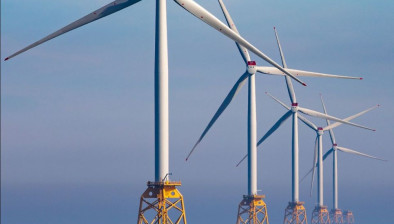Renewable energy projects win 15-year contracts after UK government auction
 Two Scottish renewable energy projects which will power more than one million homes have been awarded 15-year contracts after a UK government auction.
Two Scottish renewable energy projects which will power more than one million homes have been awarded 15-year contracts after a UK government auction.
The Moray East Offshore wind farm, planned for the Moray Firth, has been awarded a contract in the Department for Business, Energy and Industrial Strategy’s second competitive clean power auction at a price substantially lower than previous auction rounds. The project is scheduled to start generating power in 2022/23.
The result was one of three UK offshore wind projects to win a Contract for Difference (CfD) in the auction, which together signalled a considerable drop in the cost of the technology –50% since the first auction in February 2015.
Grangemouth Renewable Energy Limited also received a CfD for its dedicated biomass with CHP plant, which will be delivered in 2021/22, at a price significantly lower than the Government’s administrative strike price.
The two projects, once built, will together generate enough electricity to power the equivalent of 1,136,100 homes.
Welcoming the results, Scottish Renewables’ deputy chief executive, Jenny Hogan, said: “The results of this latest auction are good news for Scotland, for our environment and for our energy system.
“The cost reductions seen in offshore wind in particular have been dramatic and are testament to the determination of developers to drive down costs. The scale of innovation taking place across the sector and its growing supply chain show the importance of ensuring a viable, competitive route to market is available for clean power technologies.
“The biomass CHP plant at Grangemouth has also demonstrated significant cost reduction.
“However, onshore wind and solar are currently excluded from competing in Contracts for Difference auctions. The government has the tools to drive down costs even further and these technologies can and should be allowed to play their role in delivering the government’s own Industrial Strategy.”
Ms Hogan added: “We hope to see all renewable technologies getting the chance to bid in future auction rounds and to demonstrate just how cheap they can be.
“The government must now set out in its Clean Growth Plan a clear plan for cutting emissions further from the UK’s energy system, and provide certainty to investors over the timing for further auctions rounds for all technologies.”
Offshore wind cleared at prices of £74.75 per megawatt hour (MWh) for projects which will begin generating power in 2021/22 and £57.50/MWh for those commissioning in 2022/23.
At these prices, offshore wind is now substantially cheaper than new nuclear, with Hinkley Point C awarded a power contract at a price of £92.50MW/h.
Dedicated biomass with CHP cleared at a price of £74.75, against an administrative strike price of £115.
Ronnie, Quinn, chief executive of Crown Estate Scotland, which leases seabed to developers and passes rent profit to Scottish Government, said: “More certainty for Scottish projects can only be a good thing. Offshore wind directly benefits communities across Scotland by creating jobs, reducing climate change emissions and contributing to the profits that Crown Estate Scotland passes to the public purse.”
He added: “Offshore wind is an affordable and reliable source of large-scale power that is driving spend in the UK supply chain.”
The announcement comes as new data revealed that wind power output in Scotland increased by over a third in August on same period last year.
Analysis by WWF Scotland of wind and solar data provided by WeatherEnergy found that enough electricity was generated last month to power nine out ten of all Scottish households.
The environmental charity WWF Scotland said the 846,942 MWh of energy produced equates to the average energy needs of 2.25 million (93%) of Scottish homes - up 34% on the 629,603 MWh produced in August 2016.
Enough wind power was generated to potentially supply 100% or more of Scottish homes on nine days in the month and met more than 100% of total Scottish demand from homes, business and industry on two days.
Wind farms produced enough electricity to power almost half (48%) of Scotland’s total consumption for the month of 1,776,118 MWh.
On the most productive day, August 19, wind power covered the equivalent of 158% of Scotland’s total demand or nearly five million homes while on the least productive day it managed 20%.
WWF Scotland’s acting head of policy, Gina Hanrahan, said: “Renewables are working, creating jobs and investment and cutting carbon and thanks to clear policy ambition we are now a leading global player.
“August was another great month for the wind sector, providing the equivalent of 93% of the electricity needs of Scotland’s households.
“On August 19 alone, output from turbines generated enough electricity to power nearly 5 million homes or 158% of Scotland’s total electricity demand.
“Month after month renewables are continuing to play a vital role in cutting carbon emissions and powering the Scottish economy.”























